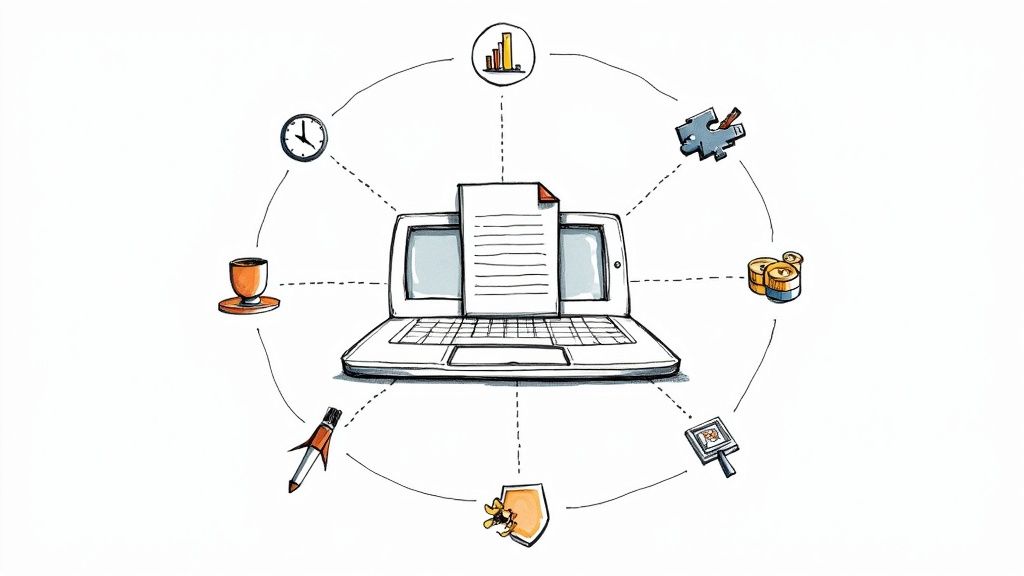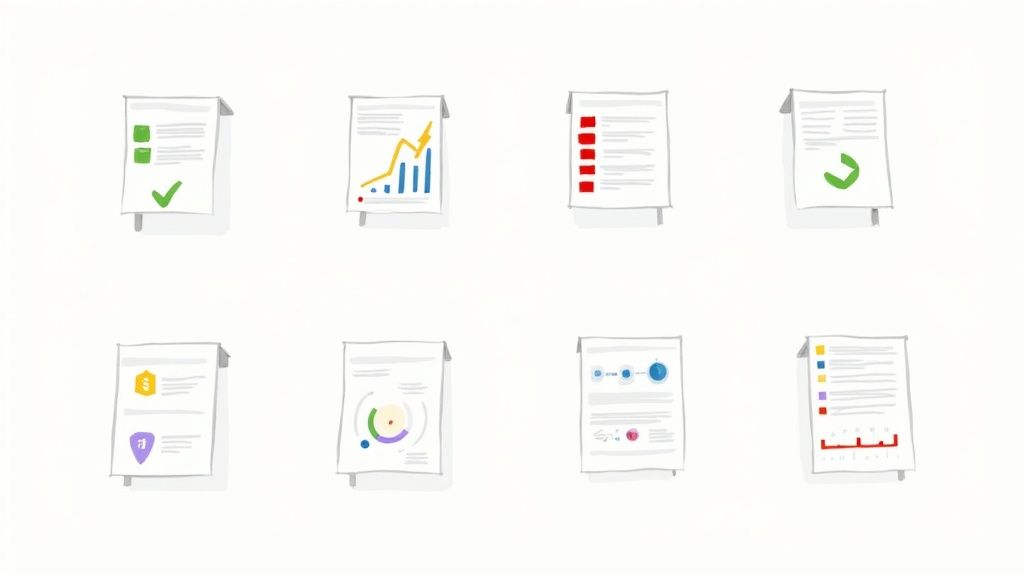
In today's fast-paced business environment, manual document processing is more than just a bottleneck; it's a barrier to growth. For small and medium-sized enterprises (SMEs), the hours spent creating invoices, drafting proposals, or managing compliance paperwork add up, stifling productivity and introducing costly errors. The pervasive impact of automation is particularly evident in human resources, where AI in HR transforming recruitment and employee experience has become a game-changer. But this efficiency isn't limited to one department; it's a company-wide advantage waiting to be unlocked.
This article explores the transformative benefits of document automation, providing a practical roadmap for key teams in finance, operations, and sales. We'll move beyond generic advice to offer actionable insights and real-world examples using tools your team may already use, such as Airtable, Glide, and Zapier. From generating dynamic reports in ClickUp to automating contracts from a CRM, you will learn how to build powerful workflows. Get ready to discover how automating your document creation can streamline operations and unlock new levels of efficiency, accuracy, and scalability for your business.
1. Increased Efficiency and Speed
One of the most immediate and impactful benefits of document automation is the dramatic boost in operational speed and efficiency. By replacing manual, repetitive tasks with automated workflows, teams can reclaim significant time. Instead of spending hours copying and pasting data, formatting layouts, or chasing approvals, employees can generate complex, professional documents in mere minutes.

This transformation allows your skilled staff to pivot from low-value administrative work to high-impact strategic initiatives that drive business growth. The core principle is simple: let software handle the repetitive tasks, freeing humans to focus on what they do best: problem-solving, creative thinking, and customer engagement.
Real-World Impact
The efficiency gains are not just theoretical; they are tangible across various industries. A sales team using a tool like Zapier can automatically generate a personalized proposal and a sales quote the moment a deal stage is updated in their CRM. This cuts the turnaround time from hours to seconds, accelerating the sales cycle. Similarly, a project manager can set up an automation in ClickUp that generates a weekly project status report, pulling task updates, timelines, and budget data into a pre-formatted document, ready for stakeholder review without any manual compilation.
Beyond large-scale document processes, automation can also streamline the creation of specific business tools, such as performance plans, demonstrating the widespread impact on efficiency. A manager, for example, could use an automated 30-60-90 day plan generator to instantly create a structured onboarding document from new hire data stored in an Airtable base. This not only saves time but also ensures consistency across the organization.
How to Implement for Maximum Efficiency
To harness these benefits, a strategic approach is key. Follow these actionable steps:
- Identify High-Volume Documents: Start by automating your most frequently created documents, such as sales quotes, invoices, or HR offer letters. This delivers the quickest return on investment.
- Map Existing Workflows: Before implementing any tool, thoroughly map your current manual process. Identify every step, bottleneck, and stakeholder to design a more effective automated flow. You can learn more by exploring different process optimization techniques to refine your strategy.
- Integrate Your Data Sources: Connect your document automation platform to your existing systems like Airtable, ClickUp, or your CRM. This enables seamless data population and eliminates manual data entry, which is a primary source of both delays and errors.
2. Enhanced Accuracy and Consistency
Another of the core benefits of document automation is the significant reduction in human error, leading to superior accuracy and consistency across all company paperwork. Manual document creation is prone to mistakes like typos, incorrect calculations, or inconsistent terminology, which can damage credibility and create legal risks. Automation standardizes the entire process, ensuring every document adheres to pre-approved templates and uses validated data.

By pulling information directly from a single source of truth, such as your CRM or an Airtable base, you eliminate the risk of copy-paste errors. This system guarantees that whether you're generating one document or one thousand, the branding, legal clauses, and formatting remain uniform. This level of consistency builds brand trust and ensures compliance with internal and external standards.
Real-World Impact
The impact of improved accuracy is profound in regulated industries. A financial services firm can use automation to generate loan agreements, ensuring every document contains the correct interest rates and regulatory disclosures, thereby avoiding costly compliance penalties. Similarly, a healthcare organization can automate patient intake forms and discharge summaries, guaranteeing patient data from their management system is accurately populated every time, protecting patient safety and privacy.
In manufacturing, maintaining consistent quality control documentation is crucial. An operations manager can connect their project management tool, like SmartSuite, to an automation platform. This allows them to automatically generate standardized quality inspection reports and certificates of conformity based on real-time production data from a specific batch, ensuring uniform quality standards are met without fail.
How to Implement for Maximum Accuracy
Achieving flawless document accuracy requires a thoughtful implementation strategy. Follow these actionable steps:
- Establish a Single Source of Truth: Designate a primary data source (like Airtable, a CRM, or your ERP) and ensure it is clean and up-to-date. All automated documents should pull data exclusively from this source.
- Use Data Validation Rules: When setting up your data sources like Airtable or SmartSuite, implement strict validation rules. For example, use single-select fields for status, number fields for currency, and date fields for deadlines. This catches errors at the data-entry stage before a document is even generated.
- Implement Template Version Control: Create a clear system for managing and updating your document templates. Ensure that only the most current, compliant template is in use across the organization.
3. Significant Cost Reduction
Beyond improving efficiency, one of the most compelling benefits of document automation is its direct impact on your bottom line. Automating document creation and management leads to substantial cost savings by reducing labor-intensive tasks, minimizing material expenses like paper and ink, and lowering physical storage requirements. This financial relief frees up capital that can be reinvested into core business activities, innovation, and growth.

The return on investment often materializes quickly, typically within 6 to 12 months. By automating, you not only cut direct costs but also mitigate the risk of expensive human errors that require time-consuming and costly corrections. This combination of reduced overhead and enhanced accuracy makes automation a powerful financial strategy for any organization.
Real-World Impact
The financial gains from document automation are evident across diverse sectors. For example, law firms have reported saving upwards of $500,000 annually by automating the generation of complex contracts and legal filings, drastically reducing billable hours spent on administrative work. In the insurance industry, companies have slashed claims processing costs by as much as 60% by automating the creation and distribution of policy documents and correspondence.
Even for smaller teams, the savings are significant. An operations manager using an Airtable base to track project milestones can automatically generate and email completion certificates, saving hours of manual work and the associated labor costs each week. Similarly, a finance team can connect their accounting software via an API to an automation tool, instantly generating and sending hundreds of invoices without manual intervention, saving both time and printing expenses.
How to Implement for Maximum Cost Savings
To realize the full financial benefits, a measured approach is crucial. Follow these steps to maximize your return on investment:
- Calculate Total Cost of Ownership (TCO): Before you begin, evaluate the full cost, including software licenses, implementation, training, and ongoing maintenance. This gives you a clear baseline to measure against.
- Track Direct and Indirect Savings: Monitor direct savings like reduced paper and printing costs, but also track indirect savings such as reclaimed employee time and the financial impact of error reduction.
- Leverage Cloud-Based Solutions: Opt for SaaS (Software as a Service) platforms to avoid the high upfront costs of on-premise hardware and infrastructure. This model often provides greater flexibility and scalability.
- Start Small and Scale: Begin with a pilot project in one department to prove the ROI. Use this success story to build a business case for broader, enterprise-wide adoption.
4. Improved Compliance and Risk Management
Navigating the complex landscape of regulatory requirements is a significant challenge for businesses, especially those in highly regulated sectors. Document automation offers a powerful solution by embedding compliance directly into your workflows, significantly reducing legal and financial risks. It ensures every document generated adheres to the latest standards and includes all mandatory legal language.

This benefit of document automation transforms compliance from a manual, error-prone checklist into an automated, systematic process. By using pre-approved templates that are centrally managed, you eliminate the risk of an employee using an outdated or non-compliant version of a form. This proactive approach to risk management protects your business from costly fines and reputational damage.
Real-World Impact
The applications in regulated industries are extensive and critical. For instance, a financial services firm can automate the generation of loan agreements, ensuring every document is compliant with Dodd-Frank and other consumer protection regulations. In healthcare, providers can automatically create patient consent forms that strictly adhere to HIPAA privacy rules, pulling patient data securely from their management system.
This level of control also applies to internal governance. An HR department using a tool like DocsAutomator can connect to their Airtable or ClickUp base to generate employment contracts. By using conditional logic within the template, the system can automatically include specific clauses required by state law based on the new hire's location, ensuring localized compliance without manual intervention.
How to Implement for Maximum Compliance
A strategic rollout is essential to leverage automation for risk management. Follow these actionable steps:
- Centralize and Control Templates: Work with your legal and compliance teams to create master templates. Store these in a central location within your automation tool and restrict editing access to authorized personnel only.
- Implement Approval Workflows: For highly sensitive documents, configure mandatory approval steps. Before a document is finalized or sent, it can be automatically routed to a compliance officer or legal counsel for review.
- Maintain Detailed Audit Trails: Ensure your automation platform logs every action, from creation to finalization. This creates an unchangeable audit trail that proves who generated what document, using which data, and when, which is invaluable during an audit. You can explore how this fits into the broader strategy of effective document lifecycle management.
5. Enhanced Collaboration and Workflow Management
Beyond just generating documents, automation platforms serve as powerful hubs for team collaboration and workflow management. By centralizing document creation, review, and approval processes, these systems break down communication silos and create a single source of truth. Manual handoffs, lost email threads, and uncertainty about a document's status become things of the past.
This benefit of document automation transforms disjointed tasks into a cohesive, transparent process. Teams gain clear visibility into who is responsible for the next step, what changes have been made, and where potential bottlenecks are forming. This structured environment ensures everyone works from the most current version, drastically reducing conflicts and redundant efforts.
Real-World Impact
This collaborative boost is evident across departments. A marketing team can use a tool like ClickUp to manage a campaign, automatically generating creative briefs from a project board and routing them for approval. When a brief is approved, a Zapier automation can notify the design team via a Slack integration and create a task in their project queue, ensuring a seamless transition from one stage to the next.
Similarly, a legal department can use a Noloco client portal to manage contract reviews with far greater efficiency. An automated workflow can send a draft agreement from a central repository to stakeholders in a specific sequence, collecting feedback and electronic signatures directly within the portal. Every action is logged, creating a clear audit trail and eliminating the need for endless email chains.
How to Implement for Maximum Collaboration
To build a truly collaborative ecosystem, focus on structuring your workflows and integrations.
- Define Clear Roles and Permissions: Before launching, meticulously map out user roles. Determine who can create, edit, approve, or only view documents. This prevents unauthorized changes and ensures the right people are involved at the right time.
- Implement Automated Notifications: Configure your system to send automatic alerts for key workflow steps. For instance, notify a manager via Microsoft Teams when a report is ready for review or alert the finance team when a sales contract is signed.
- Integrate with Communication Tools: Connect your document automation platform directly to your team's existing communication tools. Linking to platforms like Slack or Asana keeps stakeholders informed without forcing them to constantly check another system, embedding the workflow into their daily routine.
6. Better Customer Experience and Service Delivery
Beyond internal process improvements, one of the most powerful benefits of document automation is its direct impact on customer satisfaction and service delivery. By automating customer-facing documents, businesses can deliver faster, more personalized, and highly professional communications. This responsiveness eliminates frustrating delays and creates a seamless experience that builds trust and loyalty.
When customers receive accurate, well-designed documents exactly when they need them, their perception of your brand improves dramatically. Automation empowers you to meet and exceed modern customer expectations for speed and personalization, turning routine paperwork into a positive touchpoint that strengthens the business relationship.
Real-World Impact
Leading customer-centric platforms have long championed automation to enhance client interactions. The impact is clear across various sectors. For instance, a small business using Glide for its customer portal can allow clients to request a service summary. An automation then pulls their data from an Airtable base and instantly generates and emails a personalized report, a process that once took days.
Similarly, a real estate agency can connect its property database in SmartSuite to a document automation tool. When a client requests information, the agent can trigger an automation to generate a custom property report, complete with images, specs, and neighborhood data, delivering it within minutes. This level of service delivery sets a business apart from competitors still relying on manual methods.
How to Implement for Maximum Customer Impact
To leverage automation for an enhanced customer experience, focus on the user's journey.
- Design for the Customer: When creating automated workflows for customer-facing documents, prioritize a simple and intuitive user experience. If a customer needs to fill out a form to generate a document, make it as frictionless as possible.
- Offer Multiple Delivery Channels: Allow customers to receive their documents through their preferred channel, whether it's email, a customer portal, or a direct download link.
- Provide Status Updates: For more complex document generation processes, keep the customer informed. Simple progress indicators like "Generating your report..." or "Finalizing your contract..." can manage expectations and reduce anxiety.
- Integrate with Your CRM: Connect your document automation tool directly to your CRM or data source like ClickUp or Airtable. This ensures all customer data is accurate and enables highly personalized, context-aware document creation.
7. Scalability and Business Growth Support
One of the most strategic benefits of document automation is its ability to support business growth without a proportional increase in administrative overhead. As your company scales, the volume of contracts, invoices, reports, and other critical documents explodes. Automated systems are designed to handle this increased demand seamlessly, allowing you to expand operations sustainably.
This infrastructure allows your business to remain agile and efficient, even during periods of rapid expansion. Instead of hiring more administrative staff just to keep up with paperwork, you can invest those resources into core growth areas like product development, sales, and marketing. Document automation ensures your foundational processes are elastic and ready for whatever comes next.
Real-World Impact
The power of scalable documentation is evident across various business models. For example, a fast-growing SaaS startup can scale its sales team from 5 to 50 representatives, with each new member able to instantly generate compliant proposals and contracts from a central Airtable or CRM database. The system handles the ten-fold increase in document creation without any manual bottlenecks.
Similarly, an e-commerce company experiencing a surge in orders can use an API to connect their order management system to an automation tool. This allows for the automatic generation of millions of packing slips, shipping labels, and customer invoices directly from order data. This ensures fulfillment operations run smoothly without being overwhelmed by paperwork.
How to Implement for Maximum Scalability
To ensure your automated processes can grow with you, a forward-thinking approach is essential.
- Choose Cloud-Based Solutions: Opt for cloud-native document automation platforms. These solutions are built to scale automatically, handling fluctuations in demand without manual intervention.
- Design for the Future: When mapping your workflows, don't just solve for today's volume. Design processes with future growth in mind. Use dynamic templates and logic that can accommodate new products, services, or regional variations without a complete overhaul.
- Monitor System Performance: Regularly track key performance metrics like document generation time, API call success rates, and system uptime. This allows you to identify potential scaling issues proactively before they impact business operations. Platforms that integrate with no-code tools like Zapier often provide dashboards for this purpose.
8. Enhanced Data Analytics and Business Intelligence
Beyond streamlining workflows, one of the most transformative benefits of document automation is its ability to generate a rich stream of data about your business operations. Every automated document creates a digital footprint, providing valuable insights into processing times, user engagement, and workflow efficiency. This data turns your documentation process from a simple administrative function into a powerful source of business intelligence.
By leveraging this data, organizations can move from guesswork to informed decision-making. You can pinpoint bottlenecks, understand resource allocation, and measure the real-world impact of process changes. This data-driven approach allows you to continuously optimize operations and align them with strategic business goals.
Real-World Impact
The value of this data is evident across diverse sectors. A legal team can analyze the average time it takes to process different types of contracts, enabling more accurate client billing and resource planning. A sales manager can track which proposal templates have the highest close rates, using data from their CRM to optimize sales collateral.
Similarly, a manufacturing company using a tool like SmartSuite to manage quality control can automatically generate compliance reports. By analyzing the data from these reports—for instance, by exporting metadata to a CSV and analyzing it—they can monitor adherence to standards across different facilities, identify recurring issues, and implement targeted training. This not only ensures compliance but also improves overall product quality.
How to Implement for Maximum Insight
To turn your document workflows into an intelligence engine, a strategic approach is necessary. Follow these actionable steps:
- Define Key Performance Indicators (KPIs): Before you begin, determine what you want to measure. This could include document cycle time, error rates before and after automation, or the number of documents processed per employee.
- Integrate Analytics Tools: Connect your document automation system with business intelligence platforms. For example, use a Zapier integration to send data from every generated document to a Google Sheet, which can then be visualized in Looker Studio. You can learn more about how to set this up effectively by exploring reporting automation techniques.
- Establish Regular Reporting: Schedule regular reviews of the data with key team members. Use these meetings to discuss insights, celebrate efficiency gains, and brainstorm solutions for any identified bottlenecks or performance gaps.
Benefits Comparison Matrix of 8 Key Factors
Ready to Automate? Your Next Steps to a Smarter Workflow
The journey through the core benefits of document automation reveals a clear and compelling picture. We've seen how transforming manual processes into automated workflows is not just about incremental improvements. It's about fundamentally reshaping how your business operates, liberating your teams from repetitive, low-value tasks and empowering them to focus on strategic growth. From the immediate relief of enhanced accuracy and speed in your finance department to the long-term security of improved compliance in your legal and HR teams, the impact is comprehensive and profound.
The transition from tedious manual work, like copying and pasting data from an Airtable base into a Google Doc template, to a seamless, one-click operation is where the true value lies. This isn't a far-off, enterprise-level dream. For small and medium-sized businesses, this shift is more accessible than ever, creating a powerful competitive advantage by allowing you to operate with the efficiency of a much larger organization.
From Theory to Action: Your Implementation Roadmap
Understanding the benefits is the first step, but realizing them requires action. The key is to avoid getting overwhelmed. Instead of trying to automate everything at once, adopt a focused, iterative approach.
Here are your actionable next steps:
- Identify Your Biggest Pain Point: Start with the document workflow that causes the most friction. Is it generating client contracts from your CRM? Creating standardized project reports from ClickUp? Or issuing certificates from a Glide app? Pinpoint the single process that consumes the most time or is most prone to human error.
- Map the Current Process: Before you can automate, you must understand the existing workflow. Detail every step, from data source to final document delivery. Who is involved? What data is needed? Where are the bottlenecks? This map will become your blueprint for automation.
- Choose a Flexible, No-Code Tool: Your technology should adapt to your workflow, not the other way around. Look for a solution that integrates directly with your existing data sources like Airtable, SmartSuite, or Zapier. This eliminates the need for complex, custom-coded solutions and empowers citizen developers within your team to build and manage automations. To truly understand how these benefits translate into practice, exploring the specific capabilities of leading automation platforms can be incredibly insightful. You can Discover hireflyapp's automation features to see real-world examples of how data is transformed into polished documents.
- Build, Test, and Iterate: Implement your first automated workflow on a small scale. Test it thoroughly to ensure the data pulls correctly and the output meets your standards. Gather feedback from the end-users and refine the process. Once perfected, you can confidently scale it across the department or organization.
The cumulative effect of mastering these steps is a more resilient, efficient, and intelligent business. By strategically applying the benefits of document automation, you’re not just saving time; you're building a scalable operational foundation that supports sustainable growth and frees your team to do their best work.
Ready to eliminate manual document creation and unlock these benefits for your business? DocsAutomator connects directly to your favorite no-code tools like Airtable, Glide, and ClickUp, allowing you to generate custom Google Docs and PDFs automatically. Start building your first smarter workflow in minutes by visiting DocsAutomator.







